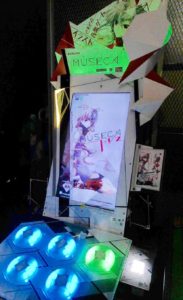What do you get when you cross spinning plates, cosplay, LEDs, and Japanese electronica?

This week’s game in Around Akiba’s Japanese Arcade Jungle is what I imagine the carnival skill of spinning plates would look like if it were ever made into an arcade game. Spinning plates, that is, if one was in cosplay, if the plates were studded with LEDs, and if they turned to the beat of Japanese electronica. Konami’s Museca (2015) is the subject of this stretched metaphor, one of the newest games in the scene, and very popular at that.
Museca attracted some controversy at launch because of its similarity to an American game called Neon FM. Gameplay-wise, however, Museca is unique for its use of rotating buttons: each of the five oversized buttons spins like a turntable, and “spin” notes are central to the gameplay. As is standard for the Japanese rhythm game, gameplay involves both regular and “spin” notes coming at you on five tracks, which you must either hit, hold, or spin in time with the music. A pedal underfoot occasionally adds to the action as well, with screen-shaking drum notes appearing to spice up the music.
Museca, not your average game center game
So far, so normal. Museca, however, is perhaps not as noted for its complex gameplay as it is for its story and mascots. Yes, you read that right: Museca has a story and level progression, making it somewhat unique among the rhythm games reviewed thus far. Unfortunately, limited Japanese ability on the part of yours truly the author makes the finer details of Museca’s story something of a mystery, but the general gist is this:
Museca’s elaborately rendered mascot characters called “Grafica” have been reduced to crude crayon drawings by some evil force. You, the player, are tasked with re-drawing the Grafica characters to their former anime splendor by completing songs in a sort of mission mode. When you have completed enough missions for an individual Grafica, they burst forth in all their HD-rendered, widescreen glory, and grant you powers which can help you clear harder songs and unlock more challenging Graficas.
There are a vast number of Grafica characters on offer for unlocking, each with CG screens and cutscenes, and new Grafica are added via internet updates as often as the ubiquitous changing music library. Thus, Museca incorporates card collecting elements of sorts, of the type made popular by mobile games like Idolish7 or Love Live. Owning and using an E-Amusement Pass for saving your progress is, therefore, more important for this game than it might be for some others.
Overall, Museca is perhaps more enjoyable for its artwork than for any particular gameplay innovation, but it’s still a fun and challenging entry that enriches any Japanese game center.
Give it a try if you can find it in the wild.
As mentioned before, use of the Konami E-Amusement Pass with Museca is highly recommended.